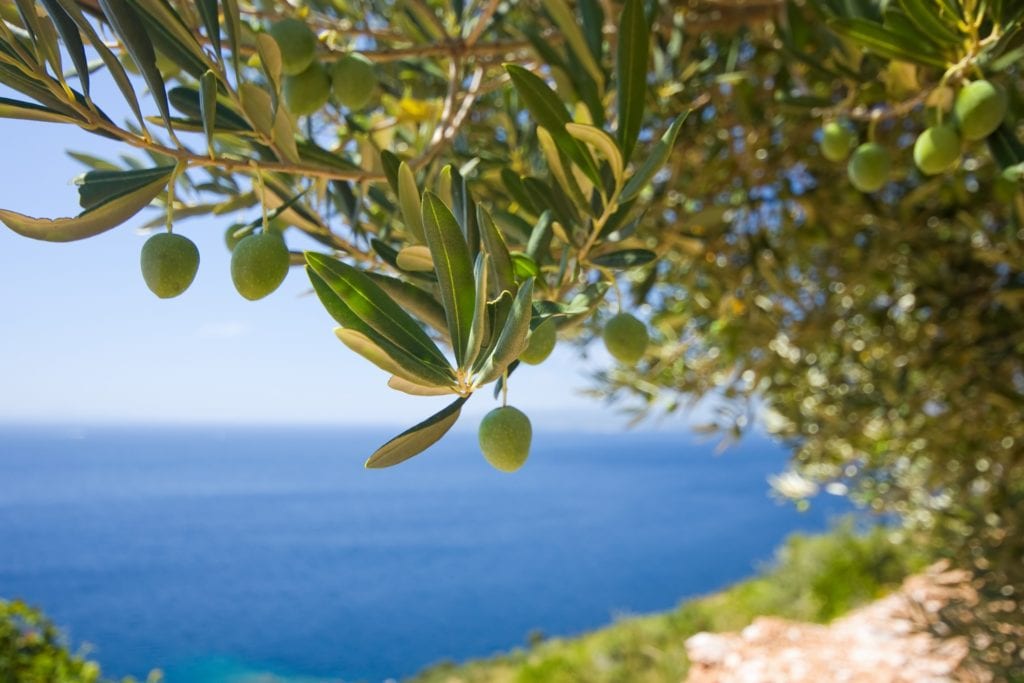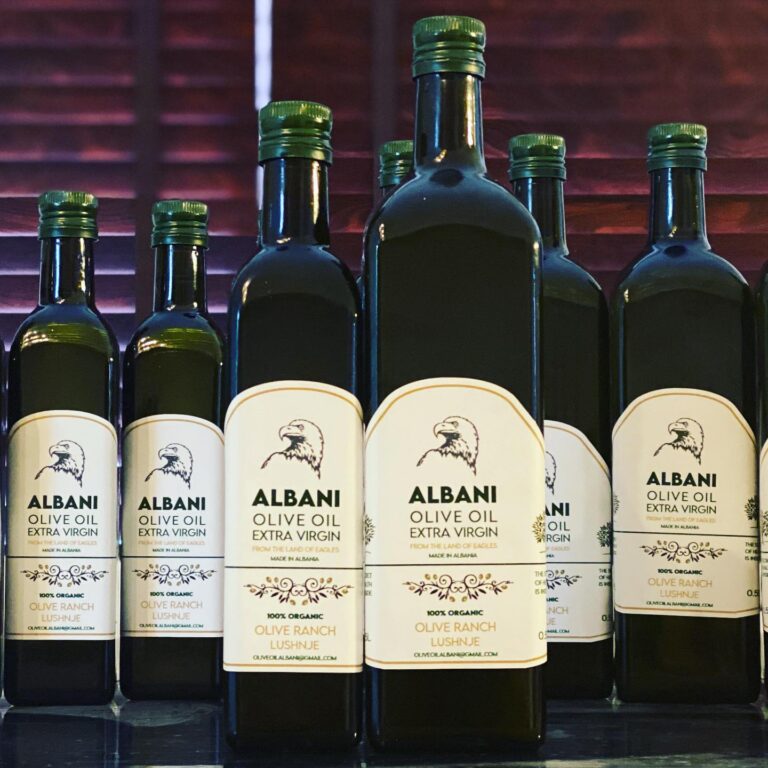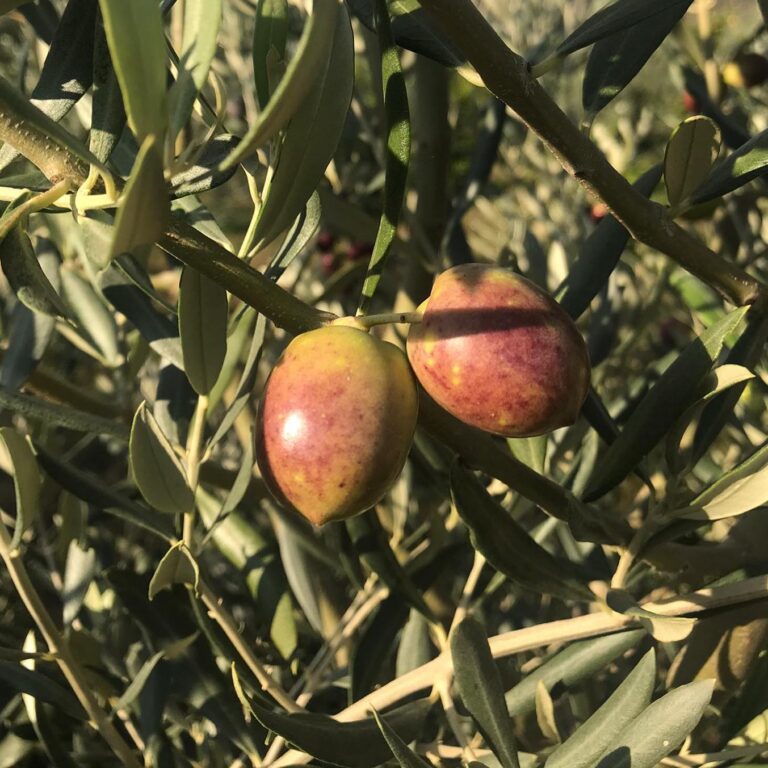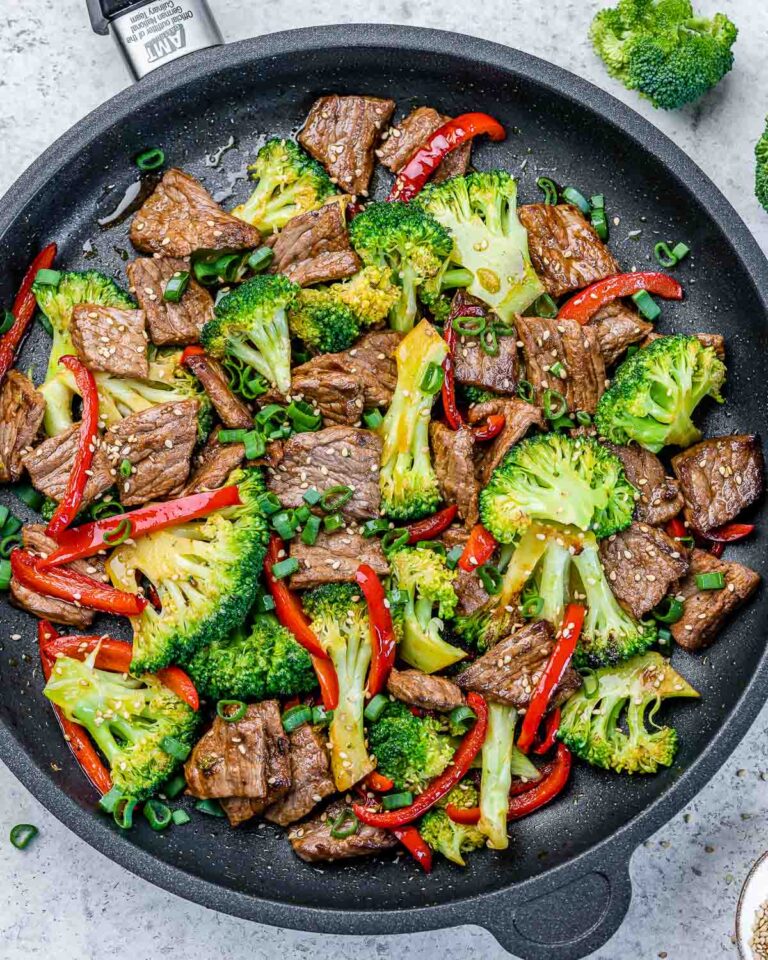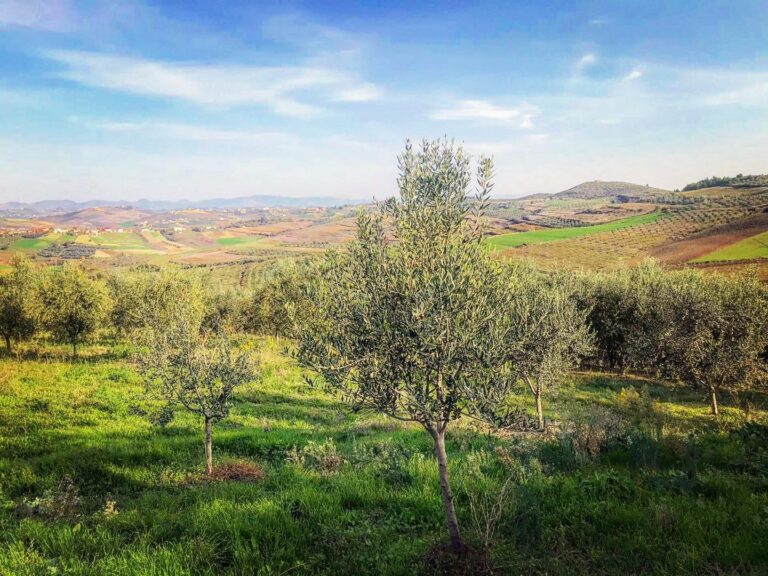The Enduring Olive: A Comprehensive Report on the Varieties, Flavors, and Culinary Traditions of Albania
The Olive as the Soul of Albanian Cuisine
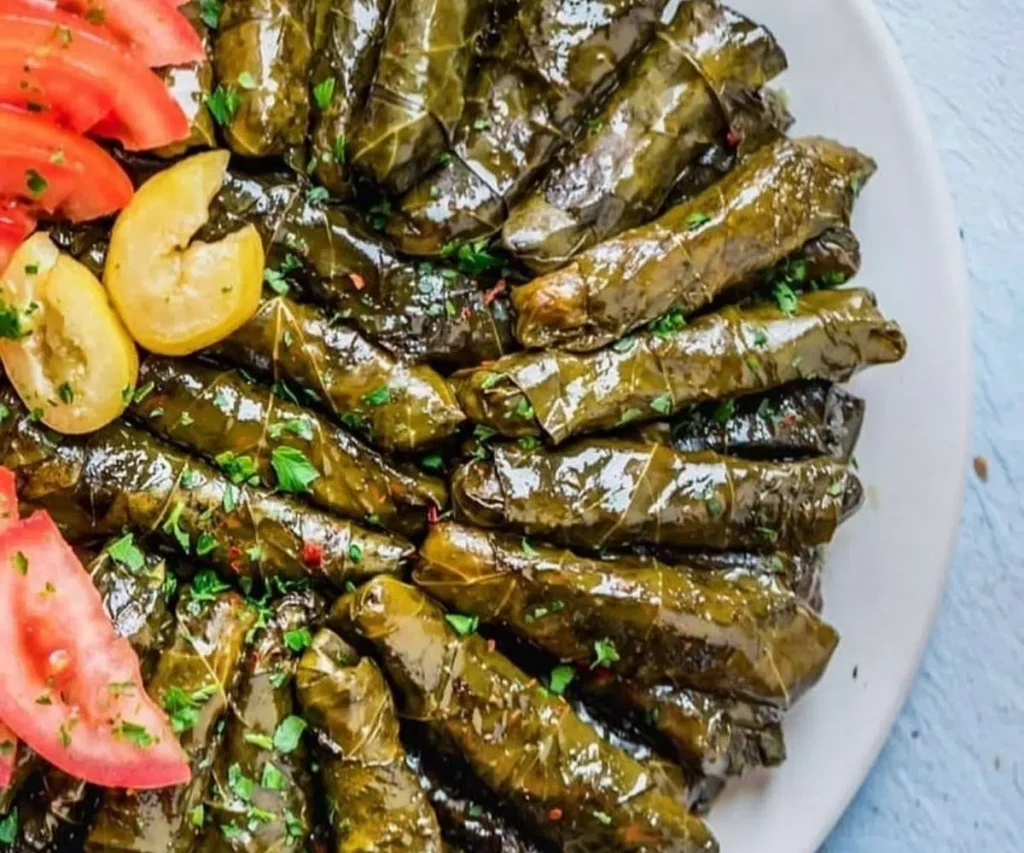
In the rich and layered tapestry of Albanian cuisine, the olive tree (Olea europaea) and its liquid gold, olive oil, are not merely ingredients; they are the foundational pillars upon which a millennium of culinary history has been built. Olive oil stands as the most ancient and consistently used vegetable fat in Albanian cooking, a tradition that stretches back to antiquity and permeates every region, particularly the sun-drenched coastal lands.1 This enduring reliance on the olive places Albania firmly within the heart of the Mediterranean culinary tradition, making its diet a quintessential example of the celebrated Mediterranean diet, which prioritizes olive oil, fruits, vegetables, and fish.1 The nation’s diverse geography and distinctly Mediterranean climate, characterized by a mosaic of microclimates, create an environment exceptionally suitable for cultivating not only olives but nearly every kind of herb, vegetable, and fruit, forming a self-sustaining pantry of profound depth and variety.1
The story of the Albanian olive is a narrative of cultural resilience, a thread of continuity woven through the diverse epochs of its history. The culinary heritage traces its origins to the ancient Illyrians, whose diet was based on the staples of the fertile land: grains, legumes, and the newly cultivated olives, grapes, and wheat.1 The subsequent influence of the Byzantine Empire reinforced these strong Mediterranean characteristics, cementing the role of olive oil, seafood, and a wide array of herbs.1 Even with the arrival of the Ottoman Empire in the 15th century, which introduced a host of new dishes such as
byrek, kebabs, and rice pilafs, along with spices like cinnamon and cloves, the foundational reliance on olive oil remained unshaken.1 The new culinary traditions were absorbed and adapted, layered upon the existing Illyrian-Byzantine foundation rather than replacing it. This persistence of olive oil as the primary culinary fat, even as other ingredients and cooking styles were integrated, suggests that it was a deeply entrenched cultural and agricultural practice—a bastion of Albanian identity that foreign influences accommodated rather than supplanted. The olive, therefore, represents not just a food source but a symbol of cultural continuity and resilience in the face of profound historical change.
Beyond its gastronomic importance, the olive tree is imbued with deep cultural and symbolic significance in Albania. It is regarded as a sacred tree, a symbol of peace, prosperity, health, and hope that is deeply embedded in the national consciousness.3 This reverence is powerfully encapsulated in a 15th-century law established by the national hero, Gjergj Kastrioti Skanderbeg, which required every newly married couple to plant two olive trees.3 This act was more than an agricultural mandate; it was a societal ritual meant to foster peace, harmony, and good fortune, tying the future of each new family to the enduring life of the olive tree. Many of the ancient trees that grace the Albanian landscape today, some over 500 years old, are a living testament to this profound legacy.3
This report provides a comprehensive exploration of the Albanian olive in all its facets. It will begin by examining the unique Albanian terroir, a mosaic of distinct micro-regions that give birth to a remarkable diversity of olive flavors. It will then present a detailed compendium of the country’s most significant autochthonous cultivars, distinguishing between those prized for their oil and those celebrated as table olives. The journey will continue from the grove to the mill, analyzing the traditional harvesting and production methods that shape the final product’s character. Subsequently, the report will delve into the kitchen, exploring the integral role of specific olive varieties and their oils in classic Albanian dishes. Finally, it will look to the future, assessing Albania’s emerging status on the world stage, its potential for international recognition through geographic indications, and the vital importance of preserving its unique olive heritage.
The Terroir of Albania – A Mosaic of Flavors
The concept of terroir, a French term that encapsulates the complete natural environment in which a particular agricultural product is produced, is central to understanding the unique character of Albanian olives. It is the intricate interplay of soil composition, climate, geography, altitude, and human tradition that imparts a “sense of place” into the fruit, creating flavor and aroma profiles that cannot be replicated elsewhere.6 Albania’s geography is a masterpiece of diversity, featuring a long coastline along the Adriatic and Ionian seas, rugged mountain ranges that rise dramatically from the coast, and fertile inland river valleys.9 This varied topography creates a multitude of distinct microclimates, each offering a unique set of conditions that have, over centuries, shaped the characteristics of the native olive cultivars that thrive within them.1 The result is a natural, terroir-driven specialization across the country, where different regions have become renowned for producing olives with distinct qualities perfectly suited for specific culinary purposes.
The Southern Riviera (Vlora & Himara): The Heart of ‘Kalinjot’ Country
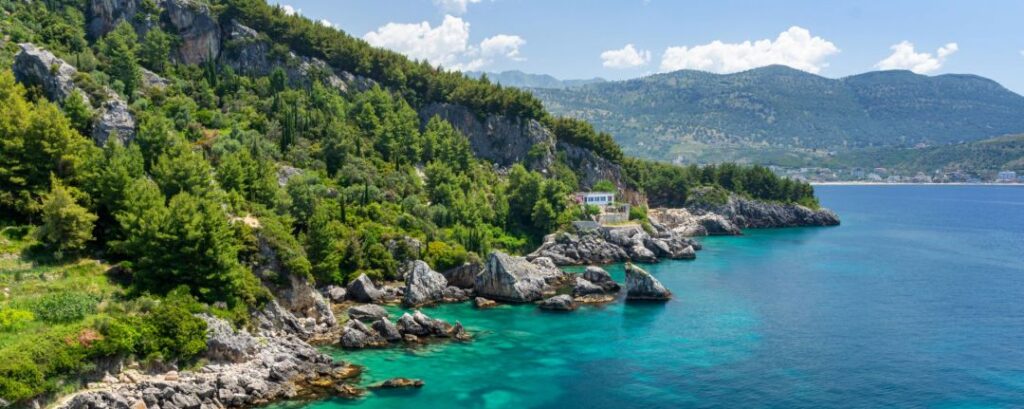
The southern coastal region, particularly the area surrounding Vlora and Himara, stands as the undisputed heartland of Albanian olive oil production and the native home of the nation’s most celebrated oil cultivar, Kalinjot.11 The terroir of this region is defined by a powerful combination of environmental factors that are almost perfectly calibrated for producing intense, high-quality olive oil. The landscape is characterized by mountainous terrain with well-drained soil, forcing the olive trees to work harder and concentrate flavors in their fruit.3 The climate is classically Mediterranean, with long, hot, and dry summers that intensify the development of polyphenols—the compounds responsible for the oil’s peppery, bitter notes and antioxidant properties—and mild, wet winters that support the trees’ health and dormancy.6
A critical element of this terroir is the constant coastal breeze that sweeps in from the Ionian Sea. This natural ventilation helps to keep the olive groves healthy and free from pests, reducing the need for chemical interventions and allowing for more sustainable, eco-friendly cultivation.3 The combination of abundant sunshine, which is crucial for photosynthesis and fruit development, and the moderating sea breeze creates an optimal environment for the slow maturation of olives, resulting in a premium extra virgin olive oil with a rich, distinctive, and robust flavor profile.3 This specific set of conditions—intense sun, coastal air, and rugged terrain—is ideally suited for an oil-focused cultivar like Kalinjot, which is prized for its high polyphenol content and complex, pungent character.11 The Vlora region, therefore, represents a terroir optimized by nature for the production of world-class, flavor-forward olive oil.
The Historic Hills of Berat: Home of the Table Olive
In contrast to the coastal intensity of Vlora, the historic inland region of Berat has evolved to become the epicenter of Albanian table olive production.17 Known as the “City of a Thousand Windows” for its stunning Ottoman architecture, Berat is surrounded by rolling hills dotted with ancient olive groves, some containing trees that are over a thousand years old.18 This region is responsible for almost half of the nation’s table olive output and is the primary cultivation area for the renowned ‘Kryps Berati’ and ‘Kokërmadh Berati’ varieties.17
The terroir of Berat is distinct from that of the southern coast. While still benefiting from a Mediterranean climate, its inland location provides a more sheltered environment. The fertile lands and rolling hills have for centuries supported the cultivation of olives prized not for their oil intensity but for their physical characteristics: large size, meaty flesh, and a favorable pulp-to-stone ratio.21 These are the defining qualities of a superior table olive, and the Berat terroir appears to be uniquely suited to nurturing them. The agricultural tradition here is deeply ingrained, with many families producing their own olive oil and curing their own table olives using methods passed down through generations.18 This specialization is not a random occurrence but a logical agricultural adaptation to a specific micro-environment. While the coastal terroir of Vlora pushes olives toward phenolic intensity, the more temperate, sheltered hills of Berat allow the fruit to grow large and fleshy, perfecting it for the table. This clear division of labor between the two regions showcases a sophisticated, albeit traditional, understanding of matching cultivar and culinary purpose to the unique characteristics of the local terroir.
Central Albania (Tirana & Elbasan): The Domain of the ‘White Olive’ and ‘Mixan’
The central region of Albania, encompassing the hills around the capital city of Tirana and the historic city of Elbasan, constitutes another vital olive-growing terroir. This area is the native home of several important autochthonous cultivars, including ‘Ulliri i Bardhë i Tiranës’ (The White Olive of Tirana), ‘Mixan’, and ‘Kokërmadh Elbasani’.3 The tradition of olive cultivation here is ancient, with historical documents showing that olive oil was exported from this region to the Republic of Venice as early as the 17th and 18th centuries, a testament to its long-standing reputation for quality.25
The terroir of this region presents a dynamic of both immense potential and significant challenges. The hills surrounding Tirana, such as in the village of Marikaj, are home to groves containing 500 to 2,500-year-old olive trees, representing an invaluable genetic and historical heritage.25 These groves produce oils with unique aromatic profiles, particularly from the ‘Ulliri i Bardhë’ cultivar.26 However, this “heritage terroir” is increasingly at risk. The rapid expansion of the Tirana urban area has created intense competition for land, leading to the neglect or destruction of ancient olive groves.27 Tirana is the only region in Albania that has marked a decrease in olive production over the past decade, a stark contrast to the growth seen elsewhere.17 This conflict between urbanization and agriculture threatens to erase some of Albania’s most unique olive genetics and the distinct flavor profiles tied to this specific terroir. The preservation of these groves, perhaps through the development of protected designations and agritourism initiatives that highlight their unique history and flavor, has become a critical issue for the future of Albanian olive heritage.25
A Compendium of Albanian Olive Cultivars
Albania is home to a rich germplasm of at least 22 documented native olive cultivars, each adapted to its specific regional terroir and possessing a unique set of characteristics.5 These varieties can be broadly categorized by their primary culinary use: those cultivated for their superior oil and those prized as table olives. A deep understanding of these key cultivars is essential to appreciating the nuances of Albanian olive products and their role in the nation’s cuisine.
The Preeminent Oil Cultivars
While many Albanian olives are dual-purpose, several varieties are celebrated almost exclusively for the exceptional quality of the oil they produce. These oils form the flavor backbone of the country’s gastronomy.
Kalinjot (also Kaninjot): The National Champion
The Kalinjot cultivar is the undisputed champion of Albanian olive oil. Indigenous to the southern regions, particularly the areas of Kalinjot, Kanina, and the broader Vlora county, this variety is the most widely distributed and economically important in the country, accounting for an estimated 50% to 70% of all olive plantations.11 Its dominance is a direct result of its exceptional quality and its perfect adaptation to the southern coastal terroir.
The sensory profile of Kalinjot oil is defined by a robust, complex, and remarkably harmonious balance of fruitiness, bitterness, and pungency.26 When crafted from early-harvest olives, it presents a vibrant, fresh character with pronounced fruity aromas of green apple, aromatic herbs, and freshly cut grass.29 This fruitiness is expertly counterbalanced by a pleasant bitterness and a signature spicy, peppery finish that lingers on the palate—a hallmark of high-polyphenol oils.30 Formal sensory panel evaluations have identified a sophisticated palette of notes, including medium green grassy tones and lighter notes of apple, almond, green leaf, artichoke, and even tomato, all harmonized with its inherent bitterness and pungency.26
Chemically, Kalinjot is renowned for its high concentration of beneficial compounds. It possesses a high level of oleic acid, a monounsaturated fat that contributes to heart health and the oil’s oxidative stability.11 Its most prized feature, however, is its rich content of polyphenols, powerful antioxidants with anti-inflammatory properties that are also directly responsible for its robust and pungent flavor profile.16 Producers of premium Kalinjot oil often aim to maximize this polyphenol content through careful early harvesting and rapid, cold-press extraction.16
In the kitchen, Kalinjot’s versatility is as notable as its robustness. It is a premier finishing oil, ideal for drizzling over dishes to add a final layer of complex flavor. Its boldness pairs beautifully with grilled meats and roasted vegetables, and it can elevate simple dishes like pasta, salads, and seafood.28 It is also exquisite on its own, served simply for dipping with fresh bread.33 The perceived paradox of Kalinjot is that while it is consistently described as “robust” and “peppery,” it is also praised as “versatile.” This reveals a sophisticated flavor structure where the robustness is not a monolithic, overpowering force but a balanced complexity. Its strength is a measure of its presence and character, allowing it to stand up to strong flavors without overwhelming more delicate ones, making it a highly valued and adaptable oil for discerning chefs.
Ulliri i Bardhë i Tiranës (The White Olive of Tirana): The Aromatic Heart of Central Albania
Hailing from the hills surrounding the capital, ‘Ulliri i Bardhë i Tiranës’ is an important autochthonous cultivar that represents a distinct and more delicate flavor profile compared to its southern counterpart. Though it comprises a smaller portion of the national total, around 4%, it is a cornerstone of the Tirana region’s agricultural identity.23
The sensory profile of this “White Olive” oil offers a fascinating contrast to the intensity of Kalinjot. It is best described as highly aromatic, with a pronounced pungent tendency, yet it is lighter and more nuanced on the palate.26 Official panel tests have characterized its flavor with light notes of apple, almond, green grassy, and, uniquely, spices and aromatic herbs.26 This suggests an oil that is less about peppery force and more about fragrant complexity, perhaps with a sweeter, more floral character.
From a chemical standpoint, Ulliri i Bardhë is a high-quality oil. Some studies have found its total phenolic content to be even higher than that of Kalinjot, indicating significant antioxidant properties and flavor potential.11 It also boasts a high percentage of oleic acid (averaging 75.62%), which ensures good stability and nutritional value.23
Its culinary applications are best suited for dishes where its delicate and aromatic qualities can be appreciated without being overshadowed. It is an excellent choice for dressing fresh greens, finishing gently cooked fish or poultry, and incorporating into vinaigrettes where its spicy and herbal notes can shine. Its subtlety may also lend itself well to baking, where a less overpowering olive flavor is desired.
Other Notable Oil Varieties
- Kushan: Another cultivar from the Tirana region, Kushan produces an oil with a sensory profile similar to Ulliri i Bardhë, featuring light notes of apple, almond, and green grass. It is aromatic and balanced, though perhaps with less of the spicy and herbal complexity found in its more famous neighbor.26
- Nisjot (Holli Himarës): A southern variety cultivated in the coastal areas of Himara and Vlora, Nisjot is used primarily for oil.3 Chemical analyses reveal it to be of exceptional quality, with a very high oleic acid content (up to 80%) and one of the highest ratios of oleic to linoleic acid, indicating superior oxidative stability. This makes it a durable, high-quality oil with excellent nutritional properties.11
- Kotruvs: Grown in the southern regions of Berat and Fier, Kotruvs is another important variety used for oil production.3
- Mixan: A key cultivar in Central Albania, particularly in the regions of Peqin and Elbasan, Mixan is primarily used for oil.3
The Celebrated Table Olives
Table olives hold a place of immense cultural importance in Albania, serving as a staple of meze platters and daily meals. The native varieties are prized for their size, texture, and flavor after curing.
Kryps (Berati, Elbasani, Krujës): The Salted King
The ‘Kryps’ family of olives represents the pinnacle of Albanian table olive production. The name itself is a linguistic key to its culinary purpose, likely derived from the Albanian word for salt, “kripë,” directly indicating its destiny as a cured, brined olive. The most prominent of these is ‘Kryps Berati’, which is considered the principal table olive of Albania. It dominates the market, accounting for over 80% of the nation’s total table olive production, and is primarily cultivated in the historic regions of Berat and Lushnje.3 Regional variations such as
‘Kryps Elbasani’ and ‘Kryps i Krujes’ are also cultivated in Central Albania and are similarly used for the table.3
The primary physical characteristics that make Kryps Berati so valued are its large fruit size and excellent pulp-to-stone ratio, which provide a satisfyingly meaty bite.21 These traits are so important that clonal selection programs have been implemented to identify and propagate trees that consistently produce large fruit with stable yields, aiming to create a more homogeneous and commercially reliable crop.21
As a brine-cured olive, its flavor profile is defined by a satisfying saltiness and savory depth. The texture is typically firm and fleshy. It is an indispensable component of the Albanian meze, served simply with chunks of salty white cheese and fresh bread.34 It is also a common ingredient in salads and is enjoyed as a daily snack, even appearing on the breakfast table.1
Kokërmadh (Berati & Elbasani): The “Big-Grained” Dual-Purpose Giant
The ‘Kokërmadh’ cultivar, whose name translates literally to “big grain” or “large kernel,” is another distinguished native variety whose name highlights its most valued physical trait: its impressive size. It is a versatile, dual-purpose olive, appreciated both as a table olive and for the unique oil it produces.19
‘Kokërmadh Berati’ is, alongside Kryps Berati, a primary table olive of the Berat region, cherished for its substantial, meaty fruit.12
‘Kokërmadh Elbasani’, cultivated in the hills north of Elbasan, is a mixed-use variety that produces round, medium-to-large fruits.24 The oil from this specific variety is deeply intertwined with the regional cuisine of Elbasan. It is considered so characteristic and essential that it is used in nearly all traditional dishes and salads, and in a remarkable display of regional culinary specificity, it can even be used as a substitute for butter in iconic recipes like
tavë kosi.24
Unfortunately, the Kokërmadh Elbasani variety faces a precarious future. It is reported that no new individual trees of this cultivar have been planted in the last 40 years, and existing trees have low resistance to diseases. This places a unique genetic resource and a key component of Elbasan’s culinary heritage at risk of being lost.24
Table 1: Profile of Key Albanian Olive Cultivars
| Cultivar Name (Translation) | Primary Region(s) | Primary Use | Key Flavor & Texture Profile | Notable Characteristics |
| Kalinjot (or Kaninjot) | Vlora, Himara, Mallakastër (South) | Oil | Robust, fruity (green apple, grass), bitter, with a strong peppery/spicy finish. | High in polyphenols and oleic acid; Albania’s most important oil variety. |
| Ulliri i Bardhë i Tiranës (White Olive of Tirana) | Tirana (Center) | Oil | Aromatic, pungent, with light notes of apple, almond, spices, and herbs. | High phenolic content; delicate and complex aroma. |
| Kryps Berati (Salted of Berat) | Berat, Lushnje (South) | Table | Savory, salty, briny flavor with a firm, meaty texture. | Principal table olive of Albania; large fruit size with high pulp-to-stone ratio. |
| Kokërmadh Berati/Elbasani (Big Grain) | Berat, Elbasan (South/Center) | Dual-Purpose | Table: Large, meaty, and round. Oil (Elbasan): Characteristic flavor used as a butter substitute in regional dishes. | Very large fruit size; Elbasan variety is integral to its regional cuisine but is at risk. |
| Nisjot (Holli Himarës) | Himara, Vlora (South) | Oil | Not fully documented, but chemical profile suggests a very high-quality, stable oil. | Exceptionally high oleic acid content (up to 80%); high oxidative stability. |
| Kushan | Tirana (Center) | Oil | Light and aromatic with notes of apple, almond, and green grass. | Similar profile to Ulliri i Bardhë, balanced and harmonious. |
From Grove to Table – The Craft of Flavor Creation
The final sensory profile of an Albanian olive or its oil is not determined by cultivar and terroir alone. It is the culmination of a series of critical decisions and meticulous actions taken by the farmer and the miller. The entire production process, from the moment the olive is picked to the final pressing or curing, is a craft dedicated to capturing and preserving the authentic flavor of the grove. This process is governed by a philosophy that treats the olive as a highly perishable fruit, where time and technique are of the essence.
The Harvest: Capturing Flavor at the Source
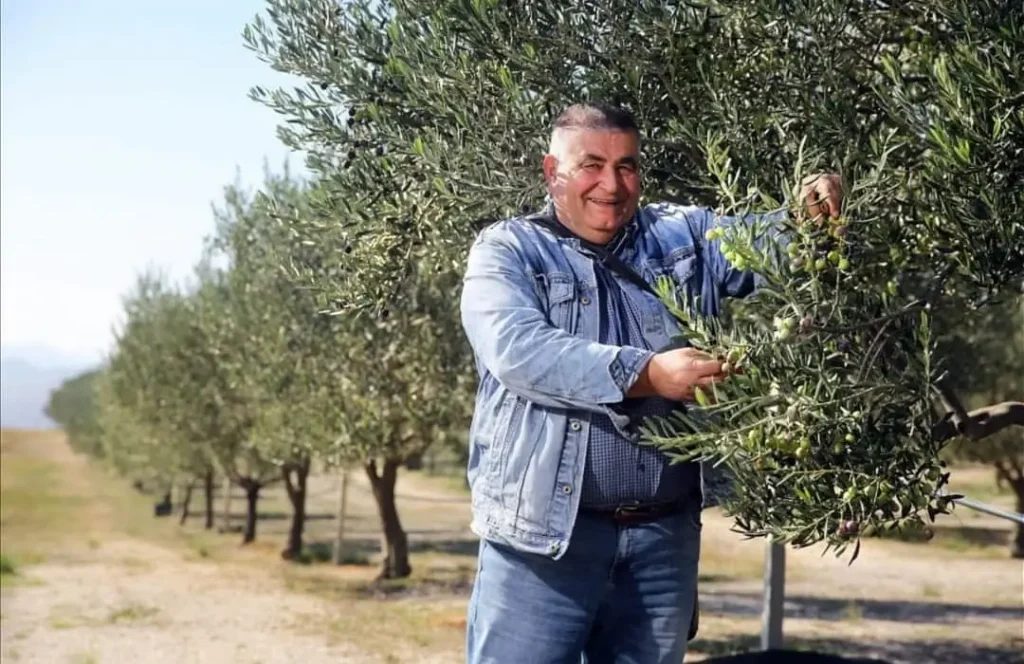
The journey from tree to table begins with the harvest, a crucial stage where the potential for quality is either secured or compromised. In Albania, particularly among producers of premium products, traditional methods are paramount.
The widespread practice of hand-picking is the first and most fundamental step in quality assurance.28 Unlike mechanical shakers that can bruise and damage the fruit, meticulous hand-harvesting ensures that the olives arrive at the mill or curing vessel intact.37 Bruising initiates oxidation and fermentation, processes that rapidly increase acidity and create flavor defects in the final oil.37 For table olives, an unblemished appearance is essential for aesthetic and commercial value. This labor-intensive method reflects a deep commitment to quality over quantity.
Equally critical is the strategic timing of the harvest, as the ripeness of the olive dictates the final flavor profile. This decision represents a fundamental trade-off between quantity and character. An early harvest, conducted when the olives are still green and not fully ripe, is the key to producing the bold, high-quality oils for which Albania is becoming known.16 At this stage, the olives contain less oil, meaning the yield is lower, but their concentration of polyphenols is at its peak. These polyphenols are responsible for the desirable sensory characteristics of a robust oil: a peppery finish, a pleasant bitterness, and herbaceous, grassy notes.37 This is the method of choice for premium Kalinjot oil. Conversely, a
late harvest, when the olives have fully ripened and turned dark on the tree, results in a significantly higher oil yield.34 However, the polyphenol content is lower, producing an oil that is milder, sweeter, and more buttery in flavor.37 For table olives, this same principle applies: earlier-picked green olives are firmer and nuttier, while later-picked dark olives are softer and meatier, offering a different textural and flavor experience.34
The Press: The Race to Preserve Freshness
Once the olives are harvested, a race against the clock begins. The production philosophy of high-end Albanian producers is defined by an urgency to minimize the time between picking and pressing, treating the olive not as a durable fruit but as a delicate one whose “living essence” must be captured before it begins to degrade. Premium producers often ensure their olives are milled within a few hours of being picked, sometimes establishing transport intervals of just three hours from the grove to the mill.16 This rapid processing is a critical quality control measure that halts the natural processes of oxidation and fermentation, thereby preserving the oil’s low acidity, high antioxidant content, and fresh, vibrant flavor profile.37
The preferred extraction method is cold-pressing. This mechanical process extracts the oil without the use of heat or chemical solvents, which would destroy the delicate, volatile aromatic compounds and degrade the beneficial polyphenols.28 By keeping the temperature of the olive paste low during malaxation (mixing) and extraction, the cold-press method ensures that the final oil is a true and unadulterated expression of the fruit. It captures the full spectrum of flavors—from fruity to grassy to peppery—and preserves the valuable health benefits, resulting in an authentic extra virgin olive oil that reflects the essence of its origin.29
The Cure: Transforming the Table Olive
Unlike most fruits, olives are inedible straight from the tree due to the intensely bitter phenolic compound, oleuropein.40 The process of curing is therefore essential to render them palatable, transforming the bitter drupe into the savory delicacy enjoyed at the table. This process is not merely a preservation technique but a form of slow, cold “cooking” that fundamentally alters the fruit’s chemistry and texture.
While modern industrial methods often use lye to speed up the debittering process, this can compromise the olive’s flavor and texture, sometimes leaving a chemical aftertaste.40 Traditional Albanian methods for table olives like Kryps and Kokërmadh rely on slower, more natural techniques that prioritize flavor development.
- Brine-Curing: This is the most common and traditional method. Olives are submerged in a high-concentration salt-water solution (brine) for an extended period, which can last from several weeks to many months.42 The salt serves two purposes: it gradually draws out the bitter oleuropein and it creates an environment where beneficial lactic acid fermentation can occur.44 This slow fermentation not only preserves the olives but also develops deep, complex, and savory flavors. This is the most probable method for the ‘Kryps’ (salty) varieties.40
- Water-Curing: This method involves repeatedly soaking the olives in fresh water, with the water being changed daily. It is the slowest of all curing techniques and is often used as a preliminary step before brining to gently leach out some of the initial bitterness, resulting in a milder-tasting final product.40
- Salt-Curing (Dry-Curing): This technique involves packing fully ripened black olives in layers of salt for a month or more.42 The salt draws out both moisture and bitterness, resulting in a wrinkled, prune-like olive with a deeply concentrated, intense flavor and a chewy texture.40 After curing, the excess salt is removed, and the olives are often bathed in olive oil to rehydrate them slightly and add richness.40
The preference for these artisanal, time-intensive methods for Albania’s principal table olives reflects a cultural commitment to flavor complexity over industrial efficiency, ensuring a product of superior taste and texture.
The Albanian Olive in the Kitchen – A Culinary Exploration
In Albanian gastronomy, olives and their oil are not ancillary items but central protagonists that define the character of the cuisine. From the sizzling base of a baked casserole to the simple, elegant garnish on a meze platter, they provide a continuous thread of flavor that runs through the nation’s most cherished dishes. The culinary philosophy often champions the “naked ingredient,” where the exceptional quality of the local cultivars is allowed to shine in preparations of profound simplicity, reflecting a deep confidence in the inherent complexity of the native olive.
4.1 Olive Oil as the Flavor Foundation
In the Albanian kitchen, olive oil is far more than a simple cooking medium; it is a primary flavoring agent that builds the foundation of countless dishes. Its application is nuanced, with the choice of oil and its method of use often reflecting deep-seated regional traditions.
A prime example of this is its role in Albania’s famous savory pies. In dishes like Byrek, a flaky phyllo pie, and Lakror, a version with thinner layers of dough, olive oil is generously used between the layers to create a crisp texture and to enrich the fillings, which commonly include meat, spinach and cheese, or leek and gjizë (a type of curd cheese).1
The use of olive oil extends to iconic baked dishes. In Fërgesë, a beloved specialty particularly from Tirana, olive oil is used to sauté bell peppers, onions, and tomatoes before they are combined with salted cottage cheese (or feta) and baked in a clay pot.49 The oil binds the ingredients into a rich, bubbling stew that is almost universally enjoyed by dipping chunks of fresh, crusty bread into the sizzling pot.49 Perhaps the most powerful illustration of olive oil as a “flavor dialect” is found in the regional preparation of
Tavë Kosi, the unofficial national dish of baked lamb and rice in a savory yogurt sauce.52 While a national staple, the version from Elbasan has a unique tradition of using the oil from the local
‘Kokërmadh Elbasani’ olive, which is so integral to the authentic taste of the dish that it is often used as a direct substitute for butter.24 This specific pairing demonstrates that Albanian cuisine is not monolithic; rather, distinct regions have evolved to use the unique characteristics of their local cultivars to define the true flavor of their most emblematic dishes.
4.2 Table Olives as a Centerpiece of Hospitality
The cured table olive is a symbol of Albanian hospitality, a simple yet profound offering that is a staple of nearly every social gathering. Its most prominent role is as the cornerstone of the meze platter. A bowl of glistening ‘Kryps’ or ‘Kokërmadh’ olives served alongside chunks of salty, feta-like white cheese, slices of fresh bread, and often a glass of the potent national spirit, raki, is the quintessential start to a shared meal.34 This simple combination is so fundamental to the culture that olives are commonly enjoyed for breakfast as well.1
The ultimate expression of Albania’s love for the olive in its pure, unadulterated form is Sallati Ulliri (Olive Salad). This dish is a masterclass in elegant simplicity, a preparation so minimal that its success rests entirely on the quality of its core ingredient.34 The recipe typically consists of a generous mix of whole green and black olives, tossed with finely chopped pieces of lemon and orange (including the rind for aromatic oils), sliced scallions, and a sprinkling of dried oregano. The entire salad is then dressed with a final, generous drizzle of high-quality extra virgin olive oil.34 There is no lettuce or complex vinaigrette to hide behind; the dish is a direct and confident celebration of the olive itself, showcasing a synergy of sweet, sour, and salty flavors. This “naked ingredient” approach is only possible when the olives possess enough inherent complexity and quality to stand as the centerpiece, a testament to the excellence of Albania’s native table varieties.
4.3 Pairing and Application Guide for the Modern Kitchen
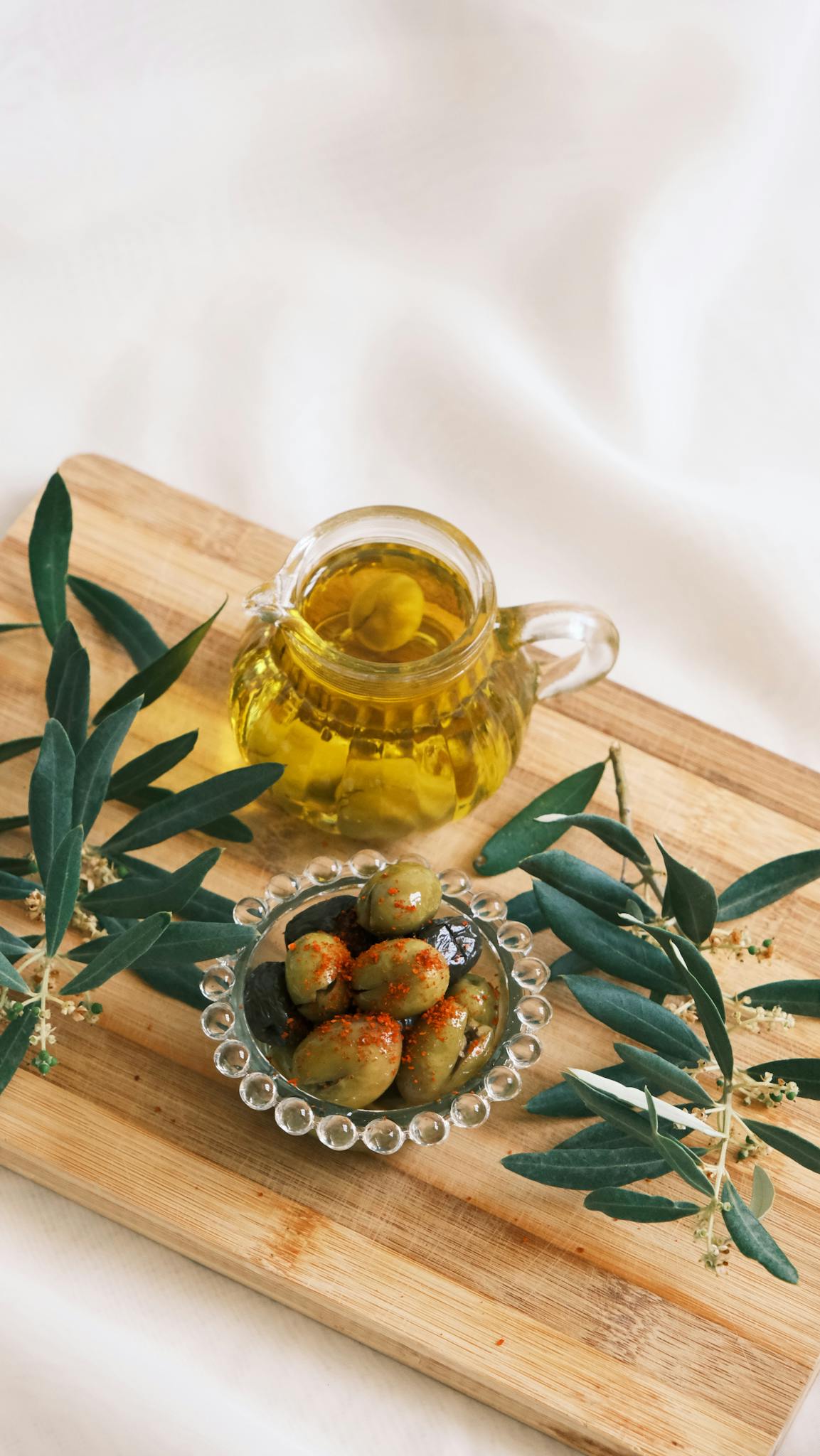
The distinct profiles of Albanian olive oils and table olives lend themselves to specific culinary applications, offering a versatile palette for both professional chefs and home cooks. Understanding these pairings allows one to harness the full potential of each variety.
- Robust Oils (e.g., Kalinjot): With its pronounced peppery finish and pleasant bitterness, Kalinjot is an ideal finishing oil for dishes with bold flavors. It stands up beautifully to the smokiness of grilled meats (mish në zgarë) and roasted root vegetables (perime në zgarë), adding a layer of pungent complexity.30 A drizzle over a hearty bean soup (
jani me fasule) or a simple pasta dish can transform it from simple to sublime.28 - Delicate Oils (e.g., Ulliri i Bardhë i Tiranës): The aromatic, herbal, and spicy notes of this oil are best appreciated in applications where they will not be overpowered. It is perfect for dressing simple green salads or for finishing delicate, flaky grilled fish (peshk në zgarë).26 Its nuanced profile also makes it an excellent choice for making high-quality mayonnaise or for use in baking recipes that call for olive oil, such as cakes or breads.
- Table Olives (e.g., Kryps, Kokërmadh): Beyond their starring role on the meze platter, these meaty, briny olives are versatile culinary ingredients. They can be chopped and added to the fillings of savory pies like Byrek or Lakror to provide bursts of salty flavor. They are a classic addition to fresh salads, such as the simple village salad (sallatë fshati) of tomato, cucumber, onion, and cheese.35 They can also be baked with feta cheese, herbs, and tomatoes for a simple and delicious appetizer, or incorporated into stews and sauces to add savory depth.
Table 2: Culinary Application Guide for Albanian Olives
| Albanian Dish / Culinary Application | Recommended Olive Variety (Oil or Table) | Rationale for Pairing (Flavor Synergy) | Preparation Note / Tip |
| Finishing Grilled Lamb (Mish qengji në zgarë) | Kalinjot (Oil) | The oil’s robust, peppery character complements the rich, smoky flavor of the grilled lamb without being overwhelmed. | Drizzle generously over the meat just before serving to preserve the oil’s fresh aromas. |
| Simple Village Salad (Sallatë Fshati) | Ulliri i Bardhë (Oil) & Kryps Berati (Table) | The delicate, aromatic oil enhances the fresh vegetables without dominating, while the salty olives provide a briny contrast to the cheese. | Use whole or coarsely chopped olives. Dress the salad just before serving. |
| Making Fërgesë (Baked Pepper & Cheese Stew) | Kalinjot or Mixan (Oil) | A good quality, flavorful oil is needed to form the rich, savory base of the dish and to withstand baking. | Use a generous amount of oil for sautéing the vegetables; the final dish should be sizzling. |
| Assembling a Meze Platter | Kryps Berati or Kokërmadh Berati (Table) | These large, meaty, and savory olives are the traditional centerpiece, pairing perfectly with white cheese and fresh bread. | Serve the olives whole in a small bowl, perhaps with a light drizzle of olive oil and a sprinkle of oregano. |
| Baking Byrek (Savory Phyllo Pie) | Kokërmadh Elbasani or other good quality oil | A flavorful but not overpowering oil is needed to brush between the phyllo layers, adding richness and ensuring a flaky texture. | Be generous with the oil between each layer to achieve the classic crispness. |
| Preparing Sallati Ulliri (Olive Salad) | Kalinjot (Oil) & a mix of Green and Black Table Olives | A high-quality, peppery finishing oil is essential to tie together the flavors of the olives and citrus in this simple, olive-focused salad. | Use whole olives for the traditional presentation. The combination of green and black olives provides contrasting textures and flavors. |
The Future of Albanian Olives – Quality, Recognition, and Heritage
After decades of relative obscurity on the international stage, Albanian olive products are beginning to garner the global recognition they deserve. This nascent emergence is driven by a renewed focus on quality, a deep connection to native cultivars, and a strategic push toward formal acknowledgment of its unique agricultural heritage. The future of Albanian olives lies at a promising yet critical juncture, balancing the opportunities of a global market with the imperative to preserve its irreplaceable genetic and cultural legacy.
The most compelling evidence of Albania’s potential is its recent success in prestigious international competitions. At the NYIOOC World Olive Oil Competition, the world’s largest and most respected quality contest, Albanian producers have secured Gold and Silver Awards for their organic, monovarietal Kalinjot oils.13 These accolades serve as powerful, independent validation that Albania can produce olive oil that stands alongside the best in the world. Such awards are crucial for building a global reputation, providing the marketing proof needed to capture the attention of discerning consumers, importers, and chefs.
This push for quality is being paralleled by a strategic move toward formal, legal recognition through geographic indication (GI) schemes. The European Union’s systems of Protected Designation of Origin (PDO) and Protected Geographical Indication (PGI) are legal frameworks that protect the names of regional products, guarantee their authenticity, and link their specific qualities to their geographical origin.54 A detailed study by the International Olive Council (IOC) has already identified a clear roadmap for potential GIs for Albanian olive products. This includes proposals for a
PDO ‘Kanina’ for oil made from Kalinjot olives in the Vlora region, a PDO ‘White olive oil of Tirana’ for oil from the Ulliri i Bardhë cultivar, and a PGI ‘Kokërrmadh i Beratit’ for the country’s most famous table olive.57 The combination of winning international awards and pursuing legal appellations reveals a sophisticated, multi-pronged strategy. The awards create the international buzz and prove the quality is achievable; the GIs would then capitalize on this by creating a legal framework to protect that quality and link it permanently to Albanian geography, transforming Albanian olive oil from an anonymous commodity into a branded, terroir-specific luxury good.
Despite this promise, challenges remain. The structure of Albanian olive farming is highly fragmented, with an estimated 80% of farms being smaller than 2 hectares.17 Furthermore, average yields per tree remain relatively low compared to other Mediterranean producers.9 While these factors can hinder scalability and consistency for mass-market production, they also present an opportunity. This structure is perfectly suited for a niche market strategy focused on high-quality, small-batch, artisanal, and single-estate oils that emphasize traceability and the unique story of their origin.
This leads to a fundamental tension at the heart of the industry’s future: the balance between modernization and heritage. On one hand, there is a clear agricultural push toward improving consistency and yield through modern techniques like clonal selection, as seen in the efforts to create a more homogeneous population of ‘Kryps Berati’ trees.21 This is necessary to produce a predictable, high-quality product for the export market. On the other hand, a significant part of Albania’s unique heritage lies in its ancient, heterogeneous groves, which contain an immense and largely unstudied genetic diversity.5 These ancient trees, some thousands of years old, are the wellspring of resilience, unique flavor nuances, and future breeding potential. The challenge for Albania will be to navigate this double-edged sword of modernization—to commercialize its olive heritage without inadvertently eroding the very diversity that makes it so special.
Preserving the Liquid Legacy
The olive tree is inextricably linked to the identity of Albania. It is a living monument to the nation’s ancient roots, a symbol of its cultural resilience, and the source of the flavor that defines its cuisine. The country’s autochthonous cultivars, such as the robust Kalinjot, the aromatic Ulliri i Bardhë, and the meaty Kryps Berati, represent a unique and valuable genetic heritage, perfectly adapted over millennia to the diverse mosaic of Albanian terroirs. The flavors they produce—shaped by the coastal breezes of Vlora, the historic hills of Berat, and the fertile plains of the central region—are an irreplaceable expression of place.
The recent international awards and the clear path toward achieving protected geographical status signal a new era for Albanian olives. The opportunity to move from a bulk commodity to a celebrated, high-value artisanal product is within reach. However, this success must be managed with foresight. Protecting and studying the ancient, genetically diverse olive groves is not just a matter of nostalgia; it is a crucial investment in the future resilience and distinctiveness of the industry. The future success of Albanian olives on the world stage will depend on its ability to champion its unique story—a story of ancient trees, distinct terroirs, traditional knowledge, and flavors that cannot be replicated anywhere else on Earth. Preserving this liquid legacy is not only an economic strategy but a cultural imperative.
Works cited
Cross-Border Territorial Development through Geographical Indications: Gargano (Italy) and Dibër (Albania) – Ricerca UniBa, accessed September 15, 2025, https://ricerca.uniba.it/bitstream/11586/414992/1/encyclopedia-02-00127-with-cover.pdf
Annex VI – List of potential GIs in IOC members – International Olive Council, accessed September 15, 2025, https://www.internationaloliveoil.org/wp-content/uploads/2019/11/Annex-VI-List-Potencial-Members.pdf
Albanian cuisine – Wikipedia, accessed September 15, 2025, https://en.wikipedia.org/wiki/Albanian_cuisine
albania & the olive – Tavoli | Albanian & Mediterranean Recipes, accessed September 15, 2025, https://www.tavoli.co.uk/inspiration/albania-and-the-olive
Most Popular Olive Varieties in Albania – Biolive, accessed September 15, 2025, https://www.bioliveoil.com/blog/most-popular-olive-varieties-in-albania
Olive tree as a way of life in the Albanian Riviera – Polis Press, accessed September 15, 2025, https://press.universitetipolis.edu.al/wp-content/uploads/2023/11/18.-Erida-Curraj.pdf
Olive in the story and art in Albania – ResearchGate, accessed September 15, 2025, https://www.researchgate.net/publication/299533090_Olive_in_the_story_and_art_in_Albania
How Terroir Shapes Olive Oil Flavor, accessed September 15, 2025, https://bhooc.com/blogs/articles/how-terroir-shapes-olive-oil-flavor
The Role of Terroir in Olive Oil Flavor Profiles: A Region-by-Region Guide – Torg, accessed September 15, 2025, https://usetorg.com/blog/the-role-of-terroir-in-olive-oil-flavor-profiles
The Role of Terroir in Olive Oil, accessed September 15, 2025, https://dellortooil.com/blogs/blog/the-role-of-terroir-in-olive-oil-why-region-matters
Map of Albania showing olive cultivation area (USAID, 2011) According… – ResearchGate, accessed September 15, 2025, https://www.researchgate.net/figure/Map-of-Albania-showing-olive-cultivation-area-USAID-2011-According-to-Figure-2-the_fig1_221923433
Discover the Albanian Olives Behind Little Olive Oil, accessed September 15, 2025, https://littleoliveoil.co.uk/blogs/little-olive-oil-notes/discover-the-albanian-olives-behind-little-olive-oil
(PDF) Characterization of Kalinjoti and Nisioti Monocultivar Virgin Olive Oils produced in Albania – ResearchGate, accessed September 15, 2025, https://www.researchgate.net/publication/315831920_Characterization_of_Kalinjoti_and_Nisioti_Monocultivar_Virgin_Olive_Oils_produced_in_Albania
Olive Oil Production in Albania, Chemical Characterization, and Authenticity – ResearchGate, accessed September 15, 2025, https://www.researchgate.net/publication/352313561_Olive_Oil_Production_in_Albania_Chemical_Characterization_and_Authenticity
Kalinjot Monovarietal Places Albanian Olive Oil on World Stage, accessed September 15, 2025, https://www.oliveoiltimes.com/production/kalinjot-monovarietal-places-albanian-olive-oil-on-world-stage/119480
Vlorë – Wikipedia, accessed September 15, 2025, https://en.wikipedia.org/wiki/Vlor%C3%AB
Olive Oil Flavor Changes by Season, accessed September 15, 2025, https://bhooc.com/blogs/articles/olive-oil-flavor-changes-by-season
Albanian Producer Pairs Local Culture, Award-Winning Quality – Olive Oil Times, accessed September 15, 2025, https://www.oliveoiltimes.com/production/donika-olive-oil-founder-aims-to-elevate-albanian-olive-oil-globally/137855
Albania – The Garden of Peace, accessed September 15, 2025, https://www.thegardenofpeace.org/thegarden/albania-statistics/
Berat Albania: Things to Do, Food and Wine, Castle and Tradition – – Sighting Sarah, accessed September 15, 2025, https://sightingsarah.com/post/berat-albania-things-to-do-food-and-wine-castle-and-tradition/
Olive Oil Production in Albania, Chemical Characterization, and Authenticity – SciSpace, accessed September 15, 2025, https://scispace.com/pdf/olive-oil-production-in-albania-chemical-characterization-1tcsl9c02j.pdf
Berat’s Golden Legacy: A story of olives, determination, and support, accessed September 15, 2025, https://www.undp.org/albania/stories/berats-golden-legacy-story-olives-determination-and-support
(PDF) Clonal selection of “Kryps Berati” variety of olive – ResearchGate, accessed September 15, 2025, https://www.researchgate.net/publication/306013105_Clonal_selection_of_Kryps_Berati_variety_of_olive
(PDF) Clonal selection of variety Kryps Berati of olive – ResearchGate, accessed September 15, 2025, https://www.researchgate.net/publication/286459484_Clonal_selection_of_variety_Kryps_Berati_of_olive
virgin olive oil production from the major olive varieties in albania – ResearchGate, accessed September 15, 2025, https://www.researchgate.net/publication/270903617_VIRGIN_OLIVE_OIL_PRODUCTION_FROM_THE_MAJOR_OLIVE_VARIETIES_IN_ALBANIA
Elbasan Kokërmadh Olive – Arca del Gusto – Slow Food Foundation, accessed September 15, 2025, https://www.fondazioneslowfood.com/en/ark-of-taste-slow-food/kokerrmadh-extra-virgin-olive-oil-from-elbasan/
Olive Oil Tour in Tirana, accessed September 15, 2025, https://www.visit-tirana.com/locations/olive-oil-tour-in-tirana/
ORGANOLEPTIC CHARACTERIZATION OF MONO CULTIVAR EXTRA-VIRGIN OLIVE OILS IN ALBANIA – Journal of Hygienic Engineering and Design, accessed September 15, 2025, https://keypublishing.org/jhed/wp-content/uploads/2020/07/01.-Fatmira-Allmuca.pdf
Olives and Olive Oil Sector Study Report Final, accessed September 15, 2025, https://bujqesia.gov.al/wp-content/uploads/2021/12/05-Olives-Sector-Study_FINAL.pdf
Kalinjot Olives in Donika Olive Oil: The Heritage of Flavor – Donika …, accessed September 15, 2025, https://donikaoliveoil.com/kalinjot-olives-in-donika-olive-oil-the-heritage-of-flavor/
Donika Kalinjot Olive Oil: The Essence of Flavor, accessed September 15, 2025, https://donikaoliveoil.com/donika-kalinjot-olive-oil-the-essence-of-flavor/
Olive Oil Flavour of Donika’s Albanian Olive Oil, accessed September 15, 2025, https://donikaoliveoil.com/olive-oil-flavour-of-donikas-albanian-olive-oil/
Authentic Albanian Olive Oil, accessed September 15, 2025, https://donikaoliveoil.com/authentic-albanian-olive-oil/
Organic Kalinjot 100% Extra Virgin Olive Oil HIGH PHENOL for Supplemental Use, accessed September 15, 2025, https://theolivegroove.com/products/kalinjot-100-extra-virgin-olive-oil-robust-intensity
Albanian Native Olives from Donika: Discover the Rich Tradition, accessed September 15, 2025, https://donikaoliveoil.com/albanian-native-olives-from-donika-discover-the-rich-tradition/
Albanian Olive Salad Recipe (Sallati Ulliri) – Real Food Traveler, accessed September 15, 2025, https://www.realfoodtraveler.com/albanian-olive-salad-recipe-sallati-ulliri/
Im in America. Please help me plan a very special Albanian meal for an elderly Albanian couple who live on my street. : r/albania – Reddit, accessed September 15, 2025, https://www.reddit.com/r/albania/comments/19aczj9/im_in_america_please_help_me_plan_a_very_special/
Why Albanian Olive Oil Stands Out from the Rest, accessed September 15, 2025, https://donikaoliveoil.com/why-albanian-olive-oil-stands-out-from-the-rest/
The Art and Science of Harvesting Olives – Torg, accessed September 15, 2025, https://usetorg.com/blog/harvesting-olives
Harvesting Methods: EVOO Quality Insights – Big Horn Olive Oil, accessed September 15, 2025, https://bhooc.com/blogs/articles/harvesting-methods-evoo-quality-insights
How to Harvest Olives – Olives Unlimited, accessed September 15, 2025, https://olivesunlimited.com/how-to-harvest-olives/
A Beginner’s Guide to Olives: 14 Types Worth Seeking Out – Serious Eats, accessed September 15, 2025, https://www.seriouseats.com/guide-to-olive-varieties
Aljeta Extra Virgin Olive Oil, accessed September 15, 2025, https://aljeta.com/en_us/product/aljeta-extra-virgin-olive-oil/
A Guide to Cured Olives – MICHELIN Guide, accessed September 15, 2025, https://guide.michelin.com/en/article/features/olive-guide-cured-kalamata-manzanilla
How to Cure Olives in Salt Brine (Step by Step) – Home Grown Happiness, accessed September 15, 2025, https://homegrownhappiness.com/salt-brine-cured-olives/
Curing table olives yourself – tips and tricks – ilcircolo – Olive Oil, accessed September 15, 2025, https://ilcircolo.eu/curing-table-olives-yourself-tips-and-tricks/
Curing Olives: Basic Brine + Salt Methods – Milkwood Permaculture, accessed September 15, 2025, https://www.milkwood.net/2021/04/28/curing-olives-basic-brine-salt-methods/
How do you process olives to make them edible? : r/culinary – Reddit, accessed September 15, 2025, https://www.reddit.com/r/culinary/comments/1mhne5r/how_do_you_process_olives_to_make_them_edible/
How to cure foraged olives, the Sicilian way | Simple 2-step process – Koren Helbig, accessed September 15, 2025, https://korenhelbig.com/cure-olives-traditional-sicilian-way/
Making Oil-Cured Black Olives | Hank Shaw, accessed September 15, 2025, https://honest-food.net/how-to-make-oil-cured-olives/
Must Try Albanian Food – Mediterranean Latin Love Affair, accessed September 15, 2025, https://mediterraneanlatinloveaffair.com/best-albanian-food/
The Best Traditional Albanian Dishes For Vegetarians – Nishi V, accessed September 15, 2025, https://www.nishiv.com/traditional-albanian-dishes-for-vegetarians/
Albanian Phyllo Meat Pie (Byrek me Mish) – Mediterranean Latin Love Affair, accessed September 15, 2025, https://mediterraneanlatinloveaffair.com/byrek-phyllo-meat-pie/
What to eat in Albania? Top 23 Albanian Foods – TasteAtlas, accessed September 15, 2025, https://www.tasteatlas.com/best-rated-dishes-in-albania
Albanian Food- 50 Delicious Albanian Dishes You Have To Try – The Food Hog, accessed September 15, 2025, https://thefoodhog.com/albanian-food/
Geographical indications and quality schemes explained – European Commission, accessed September 15, 2025, https://agriculture.ec.europa.eu/farming/geographical-indications-and-quality-schemes/geographical-indications-and-quality-schemes-explained_en
Geographical indications and traditional specialities in the European Union – Wikipedia, accessed September 15, 2025, https://en.wikipedia.org/wiki/Geographical_indications_and_traditional_specialities_in_the_European_Union
